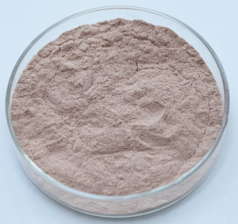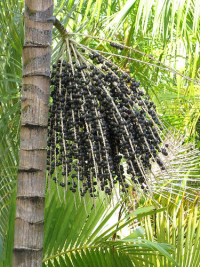13 Years Manufacturer Acai berry extract Supply to Eindhoven
13 Years Manufacturer Acai berry extract Supply to Eindhoven Detail:
[Latin Name] Euterpe Oleracea
[Plant Source] Acai Berry from Brazil
[Specifications] 4:1, 5:1, 10:1
[Appearance] Violet Fine Powder
[Plant Part Used]:Fruit
[Particle size] 80 Mesh
[Loss on drying] ≤5.0%
[Heavy Metal] ≤10PPM
[Pesticide residue] EC396-2005, USP 34, EP 8.0, FDA
[Storage] Store in cool & dry area, keep away from the direct light and heat.
[Shelf life] 24 Months
[Package] Packed in paper-drums and two plastic-bags inside.
[Gerneral feature]
- 100% extract from Acai berry fruit;
- Pesticide residue: EC396-2005, USP 34, EP 8.0, FDA;
- Directly import fresh frozen acai berry fruits from Brazil;
- The standard of the heavy mental is strictly according to the
foreign pharmacopoeia USP, EU.
- High standard of the quality of imported raw materials.
- Good water solubility, reasonable price.
[What is Acai berry]
The south American Acai palm(Euterpe oleracea)-known as the tree of life in Brazil-provides a small berry which is growing in fame, particularly following recent studies by well-known herbalists and naturopaths that have categorised it as a “superfood”. Acai berries are extremely rich in antioxidants, vitamins and minerals. The acai berry is also famous for its capacity to support dieting, protect the skin, reduce the risk of cardiovascular disease and prevent the development of certain types of cancer.
[Function]
While there are many different berry and fruit juices on the market, Acai contains the most complete array of vitamins, minerals, and essential fatty acids. Acai contains Vitamin B1 (Thiamin), Vitamin B2 (Riboflavin),
Vitamin B3 (Niacin), Vitamin C, Vitamin E (tocopherol), iron, potassium, phosphorus and calcium. It also contains the essential fatty acids Omega 6 and Omega 9, all the essential amino acids, and more protein than an average egg.
1)Greater Energy and Stamina
2)Improved Digestion
3)Better Quality Sleep
4)High Protein Value
5)High Level of Fiber
6)Rich Omega Content for Your Heart
7)Boosts Your Immune System
8)Essential Amino Acid Complex
9)Helps Normalize Cholesterol Levels
10)Acai Berries Have 33 Times the Antioxidant Power of Red Grapes and Red Wine
Product detail pictures:

Related Product Guide:
We are experienced manufacturer. Wining the majority from the crucial certifications of its market for 13 Years Manufacturer Acai berry extract Supply to Eindhoven , The product will supply to all over the world, such as: belarus, Czech Republic, Singapore, We insist on the principle of "Credit being primary, Customers being the king and Quality being the best", we are looking forward to the mutual cooperation with all friends at home and abroad and we will create a bright future of business.
Why wait Order now :
https://myrainoffice.com/enroll/self_enroll_pc.php?sponsor=125969
Information :
www.rainsoul2u.com
call & delivery +6013-373 0101
https://www.myrainlife.com/johnnylee
https://www.facebook.com/rainsoul2u
What is Rain Soul ?
Rain Soul Powerful Antioxidants & Essential Fatty Acids to energize, revitalize, detoxify your mind, body & soul. Black cumin seed, Black raspberry seed, Grape seed, Ribose-D, Resveratrol.
富 含 抗 氧 化, 人 体 内 必 需 脂 肪 酸, 帮 助 人 脑 和 身 体 排 毒. 古 书 记 载 黑 小 茴 香 除 了 无 法 起 死 回 生, 种 籽 可 做 为 每 种 疾 病 的 治 疗 药 物.
Dr Otto Heinrich Warburg (Germany)
Nobel Prize in Medicine 1931 : Biochemist
The body requires special fats that, among other important functions. make it possible for sufficient oxygen to reach the cells via the cellular membranes. Which are the key, These special fats are highly oxygen-absorbing. Called Essential Fatty Acids, or EFAs, these special fats must be supplied from outside the body every day.
Black raspberry seed :
Contain antioxidant-like phytonutrients including ellagitannins and anthocyanins. These may help fight viruses, inflammation, and a number of other serious health conditions. Antioxidants seek out and eliminate cell-damaging substances, called free radicals. Free radicals can occur naturally in the body or from exposure to environmental toxins. Although ellagitannins exist in most berries, raspberries contain the the most potent levels.
Black raspberry seed :
Contain antioxidant-like phytonutrients including ellagitannins and anthocyanins. These may help fight viruses, inflammation, and a number of other serious health conditions. Antioxidants seek out and eliminate cell-damaging substances, called free radicals. Free radicals can occur naturally in the body or from exposure to environmental toxins. Although ellagitannins exist in most berries, raspberries contain the the most potent levels.
Grape seed :
Grape seeds have an abundant source of flavonoids called proanthocyanidins. This is important for brain health due to their free radical-quenching antioxidant and collagen-protecting effects. Proanthocyanidins have also been shown to noticeably delay the onset of lipid peroxidation and to effectively chelate iron ions. Free iron ions are some of the most powerful promoters of lipid peroxide, hydrogen peroxide and hydroxyl radical production. This is a major contributor to the pathogenesis of Parkinsons disease, one of the most common neurological diseases in older individuals.
Ribose-D :
Ribose-D is a five-carbon sugar found in every cell in our bodies that combines with oxygen and ATP (adenosine triphoshate) to give energy to each cell. Ribose is also present in RNA (ribonucleic acid), which is one of the main information carriers of living organisms. Oxidative stress, as measured by free radical damage to cells, leads to systematic inflammation. Fortunately, our bodies handle this problem daily. However, if our bodies experience an abnormal increase in free radicals due to exercise, daily stress, excess smoking, excess saturated fat intake, depressed immune system, aging, etc., the body becomes fatigued and less efficient in producing Ribose-D to replenish cellular energy. Because of this, we need to supplement with Ribose-D in order to regenerate the cells energy system.
Grape Extracts Resveratrol :
Grape skin extract contains trans-resveratrol which is considered a natural antibiotic that can fight bacterial diseases. Resveratrol may help protect the body from various diseases and slowing down the aging process.
BUY NOW RAIN SOUL :
Rain International . rain soul Asia . rain soul North America . rain soul Canada . rain soul United States . rain soul USA . rain soul Europe . rain soul Germany . rain soul United Kingdom . rain soul Croatia . rain soul Hungary . rain soul Romania . rain soul Serbia . rain soul Slovakia . rain soul Asia . rain soul China . rain soul Hong Kong . rain soul Indonesia . rain soul Japan . rain soul Malaysia . rain soul Philippines . rain soul Singapore . rain soul Brunei . rain soul Taiwan . rain soul Thailand . rain soul Shanghai
BUY NOW RAIN CORE :
Rain International . rain core Asia . rain core North America . rain core Canada . rain core United States . rain core USA . rain core Europe . rain core Germany . rain core United Kingdom . rain core Croatia . rain core Hungary . rain core Romania . rain core Serbia . rain core Slovakia . rain core Asia . rain core China . rain core Hong Kong . rain core Indonesia . rain core Japan . rain core Malaysia . rain core Philippines . rain core Singapore . rain core Brunei . rain core Taiwan . rain core Thailand . rain core Shanghai
How to order rain soul . how to buy rain soul . buy rain soul . rain nutrition . rain soul how to buy . be a rain soul distributor .
God is Good & Great…!!!
Jesus Bless You & Love You…!!!
green leaf vegetables are, calorie for calorie, probably the most concentrated source of nutrition of any food. They are a rich source of minerals (including iron, calcium, potassium, and magnesium) and vitamins, including vitamins K, C, E, and many of the B vitamins. They also provide a variety of phytonutrients including beta-carotene, lutein, and zeaxanthin, which protect our cells from damage and our eyes from age-related problems, among many other effects. Dark green leaves even contain small amounts of Omega-3 fats.
Perhaps the star of these nutrients is Vitamin K. A cup of most cooked greens provides at least nine times the minimum recommended intake of Vitamin K, and even a couple of cups of dark salad greens usually provide the minimum all on their own. Recent research has provided evidence that this vitamin may be even more important than we once thought (the current minimum may not be optimal), and many people do not get enough of it.
Sales manager is very enthusiastic and professional, gave us a great concessions and product quality is very good,thank you very much!








